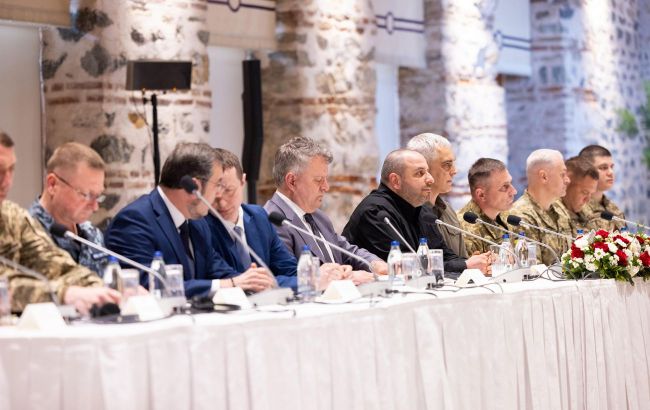Ukraine and Russia return to peace talks in Istanbul — Here's what we know so far
 Photo: The Ukrainian delegation in Istanbul during negotiations with Russia on May 16 (Getty Images)
Photo: The Ukrainian delegation in Istanbul during negotiations with Russia on May 16 (Getty Images)
Russia once again calls Ukraine to negotiations — this time with a promise to present a so-called "memorandum" outlining the terms for a ceasefire. In response, Kyiv has handed Moscow a document outlining its position and insists that the Russians do the same before a potential new meeting on Monday, June 2.
RBC-Ukraine has gathered what is known about the possible second round of talks and the positions of both sides.
Key questions:
- How did the idea of a memorandum emerge in Russia?
- Why has Ukraine still not received the document promised by the Russians?
- What points is the Kremlin trying to impose on Kyiv under the guise of peace?
- How is Ukraine responding, and what demands has it made in return?
- When might the new round of talks between Ukraine and Russia take place?
What we know about Russia's "memorandum" and its demands
After no breakthrough was reached during the May 16 Istanbul meeting on a ceasefire between Ukraine and Russia, and the US declared that the negotiation process had hit a dead end, US President Donald Trump held a phone call with Russian President Vladimir Putin.
During the conversation on May 19, the Kremlin leader expressed his readiness to offer Ukraine a memorandum on a ceasefire and a future peace treaty. He claimed that "compromises need to be found" that would satisfy both countries.
Since then, the Russian side has not disclosed the content of the memorandum. However, in recent days, Russian Foreign Ministry spokeswoman Maria Zakharova stated that the draft includes several positions, such as:
- principles of a settlement,
- timelines for a possible peace agreement,
- potential temporary ceasefire if corresponding agreements are reached.
Meanwhile, yesterday Reuters, citing three anonymous Russian sources close to the talks, revealed the conditions that Putin is setting for ending the war.
According to these sources, the Kremlin leader seeks a written commitment from Western countries not to expand the alliance eastward — meaning no NATO membership for Ukraine, Georgia, Moldova, or other former Soviet republics.
Russia also wants the memorandum to include Ukraine’s neutral status, the lifting of certain Western sanctions, addressing the issue of frozen Russian assets, and the protection of Russian-speaking citizens in Ukraine.
The Presidential Office in Kyiv notes that these demands merely demonstrate the Kremlin leadership's delusion. Once again, Putin is resorting to absurd demands, including references to Moldova and Georgia — even though those countries are not involved in the armed conflict.
Mykhailo Podolyak, advisor to the head of the President's Office, explained to RBC-Ukraine why Russia is leaking such insider details about its conditions:
“They want to use this false information to say: ‘Look, we’re ready for certain compromises, so you should be less radical.’ And once again, this is a completely obvious and rather primitive tactic that Russia constantly uses,” he said.
Russia offered date and venue for new talks, where it will present its memorandum
Regarding the timeline for delivering the memorandum, as Ukrainian President Volodymyr Zelenskyy stated yesterday, Russia had promised to provide the so-called document with specific points after the prisoner exchange in the "1,000 for 1,000" format.
The president also said that Defense Minister Rustem Umerov, who heads Ukraine's delegation in negotiations with Russia, reached out to his counterpart, Vladimir Medinsky, to find out when Ukraine would receive the memorandum.
"They kept assuring us: 'It's coming, it's coming.' But we never received anything. No one did. We turned to the United States — they’re still waiting too. Everyone is waiting," Zelenskyy said, adding that the memorandum has been awaited for over a week.
In response, Medinsky claimed that he, not Umerov, initiated the conversation and that during the call, he allegedly proposed a specific date and place for the exchange of memorandums listing the conditions for ending the war.
According to Medinsky, Russia is supposedly ready on the spot to begin substantive discussions on each point of the proposed ceasefire agreement.
“The Ukrainian side said they needed to consult. We are waiting for confirmation from them as soon as possible and are ready, on the date we proposed — in the coming days — to meet in person and start working," Medinsky said last night.
Later, Russian Foreign Minister Sergey Lavrov also made a statement, announcing that Moscow is proposing to hold the second round of talks with Kyiv on June 2 in Istanbul. Reportedly, that is where the Russian delegation will present its list of conditions for a ceasefire.
"As agreed, the Russian side promptly developed the corresponding memorandum, which outlines our position on all aspects of reliably addressing the root causes of the crisis," Lavrov said.
That same evening, Lavrov held talks with US Secretary of State Marco Rubio. According to the Russian side, they discussed preparations for the next round of Ukraine-Russia negotiations in Istanbul. However, the US State Department stated that during the call, Rubio urged the Russians to engage in a good-faith dialogue with Ukraine.
Ukraine sends its ceasefire demands to Russia
Meanwhile, the head of Ukraine’s delegation, Umerov, made it clear to the Russians that Kyiv wants Moscow to deliver the memorandum in advance for review.
"Following the meeting in Türkiye on May 16, the world expected the Russian side to formulate and send to Ukraine and its partners a memorandum outlining their vision for steps toward a ceasefire. Unfortunately, the Russian side tried to delay this process," Umerov wrote on Facebook on the evening of May 28.
However, according to him, pressure worked. And after strong statements from President Trump, European leaders, and President Zelenskyy — which demonstrated that the world is united in its pursuit of peace for Ukraine — the Russians finally announced they had completed their memorandum.
Still, Umerov noted that Russia is delaying the delivery of the document. In the meantime, Ukraine has handed over its own position paper to the Russian side.
"I gave the head of the Russian delegation our document, which reflects Ukraine’s position. They received it. We reaffirm Ukraine’s readiness for a full and unconditional ceasefire and continued diplomatic engagement," the defense minister stated.
He emphasized that the Ukrainian delegation is not opposed to further meetings with the Russians and expects their memorandum so that the upcoming meeting "isn’t just symbolic and could actually bring us closer to ending the war."
"The Russian side still has at least four days before the flight to send us their document for review," Umerov stressed.
The head of the delegation also reminded that the Russian side had promised to hand over the memorandum immediately after the prisoner exchange.
"We call on the Russian side to immediately fulfill this promise and stop trying to derail the meeting. Diplomacy must be substantive, and the new meeting must produce results," Umerov added.
Foreign Minister Andriy Sybiha also commented on Russia’s proposal to hold talks on June 2. He expressed hope that Moscow would not sabotage the next round of negotiations and “will immediately submit their proposals for our review, as previously agreed."
"Why wait until Monday? If the Russians have finally elaborated on their 'memorandum' — after ten days of reflections and attacks — it can be passed to us right away," he said.
It’s worth noting that while the Russians are delaying the delivery of the memorandum to Ukraine, they have already effectively informed the US — which is pushing for a diplomatic resolution to the war — that they will not be showing them their proposals.
A spokesperson for Russia’s Foreign Ministry said that Moscow will not share its version of the memorandum with the US. She claimed that Moscow supposedly “has no agreements” with Washington or any other countries regarding document exchanges.
Meanwhile, Washington clearly awaits Russia’s proposals. On May 27, US President’s Special Envoy on Ukraine Keith Kellogg said the United States had received proposals from Ukraine concerning a potential peace agreement. They are now awaiting similar proposals from the Russian side.
Background
On May 16, 2025, the first direct talks in three years between Ukraine and Russia took place in Istanbul. Apart from agreeing on a "1,000 for 1,000" prisoner exchange, no other results were achieved.
Although it was Putin himself who proposed the negotiations, he did not attend and instead sent a low-level delegation.
The sides failed to make any breakthrough regarding the ceasefire, which remains a key demand from Ukraine and its allies — since Moscow presented Kyiv with a series of maximalist demands.
These included Ukraine adopting a neutral status, de facto ceding five regions (including areas not currently under Russian control), withdrawal of Ukrainian forces from those areas, refusal to demand reparations, and protection of Russian-speaking population rights.
Additionally, the head of the Russian delegation, Medinsky, threatened that Russia could continue fighting "indefinitely."
More on the meeting's results can be found in the RBC-Ukraine article "All for Trump: Why negotiations in Istanbul didn’t bring war closer to end."

